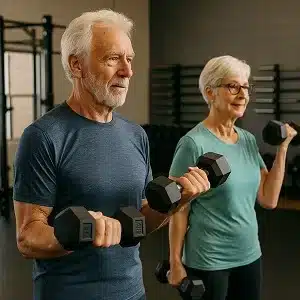Aging is not a sentence—it’s an opportunity. And while the mainstream narrative might still paint older adults as fragile, slowing down, or ready to “take it easy,” that’s a cultural myth we’re long overdue to bury. One of the most powerful tools for health, vitality, and independence after 50? Strength training. Yes, real resistance training. Lifting. Pulling. Squatting. Moving with purpose. Strength training for older adults isn’t just possible—it’s essential.
This isn’t about chasing youth or getting “shredded.” It’s about reclaiming function, building bone density, improving balance, reducing injury risk, and living with energy and confidence. Aging well doesn’t mean getting softer. It means getting smarter, stronger, and more intentional.
Why Strength Training Matters More As You Age
As we get older, we naturally lose muscle mass in a process called sarcopenia. Starting as early as your 30s, you can lose 3–5% of muscle per decade if you don’t train against it. That’s not just cosmetic—muscle supports posture, joint stability, blood sugar control, and even brain health. Without it, energy crashes, mobility declines, and the risk of falls, fractures, and metabolic dysfunction skyrockets.
Strength training for older adults counters all of that. It helps preserve lean mass, keeps mitochondria active, enhances insulin sensitivity, and strengthens the nervous system. The result? More vitality, better balance, sharper thinking, and a body that actually supports you—rather than slows you down.
What Strength Training Looks Like for Older Adults
You don’t need Olympic lifts or barbell back squats to see results. Functional, safe, and progressive resistance is the goal. That can look like:
-
Bodyweight movements: squats, pushups (even wall pushups), glute bridges
-
Resistance bands for pulling and pressing
-
Light to moderate dumbbells or kettlebells
-
Machines for leg press, rows, or shoulder presses
-
Balance work: step-ups, single-leg exercises, core engagement
-
Controlled tempo and proper breathing
The key is consistency and progression. Start small, build slowly, and focus on form. Two to three sessions a week can completely change your trajectory.
Bone Density, Hormones, and Longevity
Here’s something you won’t hear enough—strength training for older adults is one of the few proven ways to build bone density. It stimulates osteoblasts, the cells that produce bone tissue. Especially for postmenopausal women, that’s critical. Strong bones mean fewer fractures and greater independence.
Strength training also improves hormonal balance. It can boost testosterone and growth hormone, regulate cortisol, and even improve sleep—all of which contribute to a stronger immune system and a more youthful metabolism.
Mental Health and Confidence
There’s something primal about lifting something heavy and setting it back down. It reminds you that you’re still capable. Still powerful. Still alive. Strength training isn’t just physical—it’s deeply psychological. It builds confidence, discipline, focus, and self-trust.
Older adults who engage in strength training report lower rates of anxiety and depression, better cognitive function, and a greater sense of purpose. And no surprise—it’s hard to feel helpless when you can deadlift your bodyweight or carry groceries without strain.
It’s Not About Age—It’s About Intent
The truth is, it’s never too late to start. People in their 60s, 70s, and even 80s are walking into gyms, grabbing dumbbells, and transforming their lives. This isn’t about becoming a bodybuilder. It’s about becoming functional, independent, and resilient. Strength training for older adults is the antidote to decline. It’s how you build the physical insurance policy that lets you travel, play with your grandkids, hike trails, or simply get out of a chair with ease.
Don’t let the outdated story of aging write your next chapter. You get to choose how strong you’ll be tomorrow, and it starts today.

